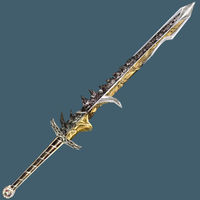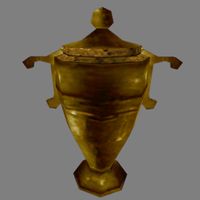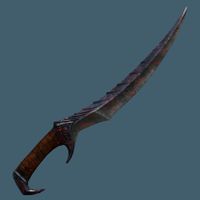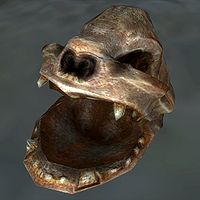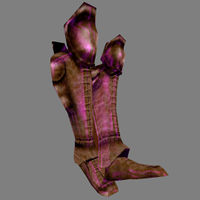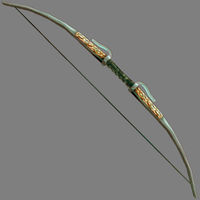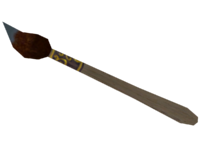Lore:Artifacts B
Barilzar's Mazed Band
Barilzar's Mazed Band was an artifact of immense power created by the mage Barilzar in the middle of the Second Era. Barilzar created the ring as a means of teleportation, but the ring's powers far exceeded his intentions. The Band was able to open rifts in time and space, and could even open the gates of Oblivion, releasing nightmarish creatures upon the land. The ring was cursed and stripped of its power, so that only a god could use it without being destroyed. This curse is thought to have resulted in the death of Barilzar, although the mage lived on as an undead lich and was sealed within an abandoned crypt in Old Mournhold, along with the ring.
In the late Third Era, the cave-in blocking his crypt was excavated at the orders of Almalexia, linking it to the temple sewers beneath the city of Mournhold. In 3E 427 Almalexia sent the Nerevarine to retrieve the ring from the crypt. Barilzar defended the Band with his life, determined that the artifact should never be used again, but he was slain and the ring was brought to Almalexia. Although the ring was cold, the embers of its power still burned within, and she used her magic to reawaken its power.
Although she had claimed that possession of the ring would help her to better care for her people, Almalexia had obtained the ring for a malicious purpose. Driven to madness by the loss of her divinity, she planned to murder her fellow Tribunes, Sotha Sil and Vivec, as well as the Nerevarine. Her first target was Sotha Sil, who had withdrawn from the world and now dwelled within his Clockwork City. She used the Mazed Band to journey to the Clockwork City and kill Sotha Sil. She then used the ring to teleport verminous and hulking fabricants from the Clockwork City to Mournhold. These half-robotic reptilian abominations were the spawn of Sotha Sil, and they caused havoc in the streets of Mournhold. Almalexia then claimed that the reclusive Sotha Sil had been driven mad and was launching an attack on the city. Using this ruse, she tricked the Nerevarine into going to the Clockwork City to kill him. There, Almalexia confronted the Nerevarine, but she was defeated in combat. The Nerevarine took the Band and used it to teleport back to Mournhold. The ring had the ability to teleport its wearer between Mournhold, the Clockwork City and Vivec City, or temporarily summon a fabricant; no elements of its curse or evil powers remained.
Found in:
BiPolar Blade
The BiPolar Blade is a strange artifact of some renown. According to legend, a nobleman sank his fortune into creating a longsword of supreme power. Two smiths on opposite ends of Tamriel created each half of the blade, unaware of the other, with the hope that no one man, save the owner of the blade, would know its true power. Unfortunately, the smiths were not given enough instruction, and created halves with enchantments that completely negated each other.
The blade is simply regarded as an expensive curiosity for collectors. By 3E 427, it had come into the possession of Sunel Hlas, a wealthy trader and widower living in Mournhold. It is rumored that Hlas relinquished ownership of the blade later that year, and it was given to Torasa Aram to be put on display in her museum of artifacts.
Found in:
Bittercup
The Bittercup, or the Bitter Cup, is an artifact sacred to Clavicus Vile, and thus is highly prized by the followers of that Daedric Prince. The Cup was lost in ancient Chimeri ruins on an island in the Sheogorad region of Vvardenfell before it was recovered by the Nerevarine in 3E 427.
Found in:
Black Books
Black Books are Daedric artifacts created by Hermaeus Mora, the Daedric Prince of Fate and Knowledge. Each book contains some manner of forbidden knowledge. Some books are from the ancient past; some are from the future. The thick tomes are bound in black covers, with a symbol representing Mora on the front, and emit a black mist. They are comparable to the Oghma Infinium, another tome of knowledge created by Mora; however, through the reading of the Black Books, individuals can obtain much more power than that gained from the Oghma Infinium alone. The books were spread across Tamriel by Mora, and are usually located in the depths of ancient dungeons.
Through reading a Black Book, the reader will enter Apocrypha, the realm of Oblivion created and ruled over by Hermaeus Mora. Tentacles will emerge from the tome and envelop the reader. An apparition of the reader's body remains in Mundus, tethering their life force. Most mortals who read a Black Book are driven insane, but those who successfully journey through Apocrypha are known to discover powerful knowledge. Dying in Apocrypha while reading a Black Book simply banishes the reader back to Tamriel. Rereading a book will return the reader to the same area of Apocrypha, allowing them to attempt Mora's gauntlets again or harness the power of a different piece of knowledge. Copies of the contents of Black Books can be made without entering Apocrypha.
Found in:
Blade of Woe
The Blade of Woe is an ebony dagger associated with the Dark Brotherhood. It appears a simple dagger, but it is a potent weapon in the right hands. At its most lethal, the dagger damages health and magic, and demoralizes anyone struck by it.
In 3E 433 the unblooded blade was given by Lucien Lachance to a murderer when they were invited to join the Brotherhood. That murderer did join the Brotherhood, and rose through the ranks maintaining possession of the simple dagger. After the Purification of the Brotherhood, and the subsequent decimation of the Black Hand ending with Lachance's own death, the murderer-turned-assassin attended a meeting to summon the Night Mother below the Lucky Old Lady statue in Bravil. During that meeting the true traitor to the Brotherhood was revealed, and as a reward for proving their loyalty, the Blade of Woe's true power was unlocked to the newly promoted Listener.
In 4E 201 the Blade of Woe was in the possession of Astrid, the leader of the last known active chapter of the Brotherhood. Astrid was killed by the murderer of Grelod the Kind. This murderer took possession of the Blade and nothing has been heard of its whereabouts since.
Found in:
Bloodskal Blade
The Bloodskal Blade (also known simply as Bloodskal) is an ancient Nordic artifact. In appearance it is an enchanted silver sword, either a long blade or a greatsword, sometimes decorated with red markings. It has the power to either cause magical frost damage to those that it strikes, or release a ribbon of mystical energy, a red energy blast which can hit an out-of-reach target.
The blade was created by the Bloodskal clan, a clan of Nords on Solstheim. It came to rest in Bloodskal Barrow, guarded by draugr. The energy blasts released by the blade were necessary to open a strange door within the ruins. In 3E 427, the sword was discovered by the Nerevarine, on an altar near the entrance to the barrow. The Nerevarine took the sword, which summoned several undead skeleton guardians.
By 4E 10, the artifact had returned to the ruins of Bloodskal Barrow. It was placed on a pedestal, in a large chamber behind the door which required the sword to open. That year, the East Empire Company broke through into the ruins from the Raven Rock ebony mine. Gratian Caerellius and his assistant Millius were tasked with exploring the ruins. Gratian discovered the sword, but removing it from its pedestal awoke a horde of draugr. The two adventurers died from their wounds, and the EEC sealed the ruins, claiming that Gratian had died in a tunnel collapse.
In 4E 201, Gratian's great-grandson Crescius Caerellius uncovered old documents belonging to his ancestor, which affirmed his suspicions over the cause of Gratian's death. An old man, Crescius was unable to venture into the mines; instead, he enlisted the help of the Last Dragonborn, who then unsealed the entrance to the ruins and discovered Gratian's body, along with the Bloodskal Blade. The Dragonborn used the blade to open the door in the ruins and escape the barrow, and related the discovery of Gratian's remains to Crescius.
Found in:
Bloodworm Helm
The Bloodworm Helm is an evil trollbone helmet created by Mannimarco, the King of Worms. Although beautiful to behold, many find the artifact repulsive due to its necromantic nature. The helm grants the wearer greater skill at Conjuration, as well as the ability to turn the undead, drain the essence of enemies and summon a skeletal minion from the Soul Cairn. Mannimarco left the helm behind when he ascended to godhood during the Warp in the West.
By 3E 427 the helm had come into the possession of a Nord necromancer named Crazy Batou, who had established a lair in an ancestral tomb in the Molag Amur region of Vvardenfell. Batou was killed by the Nerevarine, who then sold the helm to Torasa Aram. Torasa put the helm on display in the Mournhold Museum of Artifacts. It was later obtained by the Mages Guild, and transported to the Arcane University in Cyrodiil for safekeeping. In 3E 433, Mannimarco returned to the affairs of mortals and attempted to destroy the Mages Guild. The Council of Mages dissolved in the ensuing attacks on the guild, and Master-Wizard Irlav Jarol took the helm to the abandoned Fort Teleman in Blackwood with a group of researchers to study the artifact in an effort to better understand how Mannimarco could be stopped. The expedition went against the advice of Arch-Mage Hannibal Traven, who feared for the group's safety. Traven was proven correct when Irlav's experiments resulted in the summoning of many dangerous Daedra; Irlav himself was slain by a hostile Dremora. The Order of the Black Worm then launched an assault on Fort Teleman to recover the artifact for Mannimarco, but they were held at bay by the Daedra. A member of the Mages Guild was sent by Traven to recover the helm, and stumbled into the ongoing battle. The mage successfully infiltrated the ruins and took the helm from Irlav's corpse. It was then brought back to the University and returned to a secure place in the Arch-Mage's Tower.
Found in:
Book of Life
The Book of Life was a census record kept by the Nords in the early First Era. Mentioned in A History of Daggerfall, it is noted as "one of the first civilized acts the Nords performed". It is believed to be the first census kept by humans on Tamriel. The book was used to keep track of the population of newly conquered High Rock, including Daggerfall, which was founded by the Nords as a fort-town to support their raids. On the settlement of Daggerfall the Book of Life says:
- "North of the Highest bluffs, south of the moors, west of the hills, and east of the sea is called DAGGERFALL. 110 men, 93 women, 13 children under 8 years of age, 58 cows, 7 bulls, 63 chickens, 11 cocks, 38 hogs live here."
The exact length of the Book of Life remains unknown, but the info on Daggerfall is found on page 933.
Found in:
- Daggerfall (mentioned only)
Boots of the Apostle
The Boots of the Apostle are very mysterious. The wearer of the boots is rumored to be able to levitate, though sightings of them in use have been extremely rare. They are relics of Tiber Septim and legendary treasures of Cyrodiil. The Nerevarine reportedly recovered the boots and sold them to the Mournhold Museum of Artifacts in 3E 427.
Found in:
Bow of Shadows
The Bow of Shadows is a Daedric artifact that, according to legend, was forged by the Daedric Prince Nocturnal. The legendary ranger, Raerlas Ghile, was granted the Bow for a secret mission that failed. The Bow was lost, though Raerlas is said to have used it to take scores of his foes down with him. The Bow is said to grant the user invisibility and increased speed. Many sightings have been reported; it is said that the Second Era Dunmer assassin Dram once wielded it. Dram likely used the Bow during the Battle of Hunding Bay, when he shot Prince A'tor with the poisoned arrow that eventually killed him. Dram also made use of the bow during the rebellion of Stros M'Kai, led by the Restless League, most notably in battle against Cyrus the Redguard.
Near the end of the Third Era, the Bow came into the possession of a necromancer named Goris the Maggot King. In 3E 427, the Nerevarine killed Goris and his accomplice Luven in the Venim Ancestral Tomb, a tomb in the Grazelands of Vvardenfell which Goris used as a lair. The Nerevarine then retrieved the Bow. Later that year, the Bow was sold to Torasa Aram and put on display in her Museum of Artifacts in Mournhold.
Found in:
Brush of Truepaint
The Brush of Truepaint is an Aedric artifact supposedly created by Dibella. It is said that the bristles of the brush were woven from of Dibella's own hair. The brush allows the wielder to enter a painting canvas and paint things life-sized, simply by imagining them.
At some point before 2E 582, a Dunmer wizard named Bravam Lythandas was performing a cruel experiment in illusion on three captives he was keeping in his basement. He had magically tricked them into believing they were living in a palace, although over time the illusions began to damage their minds. As they descended into madness, one of the captives began rocking back and forth and muttering prayers to Dibella. Several days later, Bravam returned to find the basement entirely empty, with the walls, ceiling, and floor completely covered with a mural depicting the grand chamber of a palace. The only thing remaining was the Brush of Truepaint lying in the corner, which the captives had apparently used to escape into their fantasy world.
Bravam's experiment journal went on to become a tome of forbidden knowledge, hoarded by Hermaeus Mora. At some point a Khajiit named Baezad-dro went looking for the Brush of Truepaint, although he was killed by a daedroth when he tried to read the journal. The journal eventually ended up on the small island of Khenarthi's Roost along with several other tomes of forbidden knowledge. In 2E 582, Sybil Augustine Viliane of Wayrest received a cryptic message regarding the location of the brush and how it could be obtained.
The brush was later gifted to a descendant of Bravam Lythandas, an artist and devout follower of the goddess who served in the Arnesian War of 3E 396. An errant fireball exploded next to him, and he lost the use of both arms. He was a stubborn man, and prayed to Dibella for a way to continue his trade. When the Dunmer artist died, he left the brush to his son, who went on to become the famous Rythe Lythandas of Cheydinhal. Rythe specialized in painting the Great Forest of Cyrodiil; these paintings are famous all across Tamriel for their realism, and some say that one can see the trees sway in the breeze.
In 3E 433, a Bosmer or Altmer thief (reports vary) learned of the brush, the source of Rythe's fame. In an attempt to steal the artifact, the thief broke into Rythe's house, knocked him unconscious and leapt into the unfinished painting he was working on. The thief then created Painted Trolls to act as guardians, but the beasts turned on their creator and killed him. Rythe followed the thief into a painting, and became stuck there, unable to create a portal back without the brush. His wife Tivela, who was unaware of the Brush of Truepaint, put out a request to help "find" him. After several days, the Champion of Cyrodiil responded to the rumors, and entered the Painted World. The Champion met with Rythe, and fought through the Painted Trolls to the corpse of the thief. With the brush retrieved, the two were able to exit the Painted World. A special edition of The Black Horse Courier titled Greatest Painter Safe! was published following the incident.
The fat collected from the Painted Trolls proved to be very valuable in alchemy, and Rythe, being the only provider of this rare ingredient, began to exploit this. One known patron of his was Elgrim, an alchemist living in Riften in 4E 201.
Found in:
